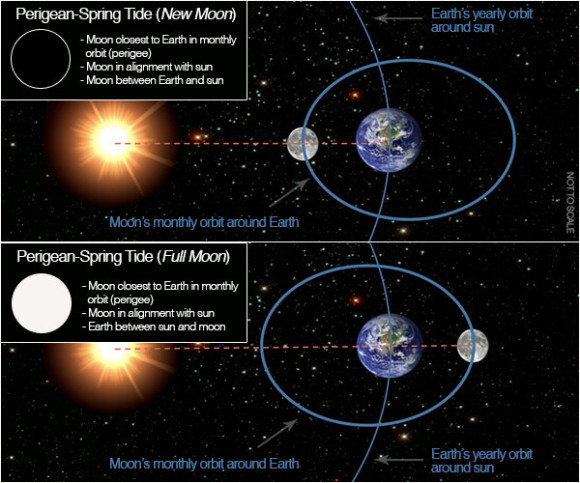
Image via Bedford Astronomy Club.
The diagram above helps to explain why new and full moons come especially close to Earth when they coincide with perigee, and swing especially far away from Earth at apogee. Take a careful look. Explanation below.
On the diagram above, the line connecting lunar perigee with lunar apogee defines the moon’s major axis (the longest axis of an ellipse).
When the moon’s major axis (apogee-perigee line) points sunward (A & C on the diagram), the eccentricity (flatness) of the moon’s orbit is increased to a maximum. A greater eccentricity lessens the perigee distance, while increasing the apogee distance.
At A in the diagram, it’s a perigee new moon (supermoon) and an apogee full moon (micro-moon).
Then 3.5 lunar months (some 103 days) later, at B in the diagram, the major axis is at a right angle to the sun-Earth line, so the eccentricity of the moon’s orbit is minimal. At such times, the moon’s orbit is closest to circular. It’s a more distant perigee and closer apogee, with the first quarter and last quarter moons more or less aligning with apogee and perigee.
Then 7 lunar months (206 days) later, the major axis again points sunward. Once again, the eccentricity of the moon’s orbit is increased to a maximum, lessening the perigee distance yet increasing the apogee distance. This time around, it’s a full moon perigee and new moon apogee. See C in the diagram.
Dates for apogee/perigee new/full moons (2017 Dec. 18 to 2019 Feb. 19):
2017 December 18: apogee new moon (farthest apogee in 2017)
2018 January 2: perigee full moon (closest perigee in 2018)Seven lunar months later:
2018 July 13: perigee new moon (2nd-closest perigee in 2018)
2018 July 27: apogee full moon (2nd-farthest apogee in 2018)Seven lunar months later:
2019 February 4: apogee new moon (farthest apogee in 2019)
2019 February 19: perigee full moon (closest perigee in 2019)

Top: When the moon’s major axis (perigee-apogee line) points sunward, with perigee residing between the Earth and sun, the result is a new moon at perigee. Bottom: Some 206 days later, the moon’s major axis again aligns with the Earth and sun, but this time around, perigee is opposite the sun in Earth’s sky, giving rise to a full moon at perigee. Image and caption via NOAA.
Bottom line: An explanation of why extra-close perigees and extra-far apogees happen at new and full moons.
from EarthSky https://ift.tt/2mfeD4d

Image via Bedford Astronomy Club.
The diagram above helps to explain why new and full moons come especially close to Earth when they coincide with perigee, and swing especially far away from Earth at apogee. Take a careful look. Explanation below.
On the diagram above, the line connecting lunar perigee with lunar apogee defines the moon’s major axis (the longest axis of an ellipse).
When the moon’s major axis (apogee-perigee line) points sunward (A & C on the diagram), the eccentricity (flatness) of the moon’s orbit is increased to a maximum. A greater eccentricity lessens the perigee distance, while increasing the apogee distance.
At A in the diagram, it’s a perigee new moon (supermoon) and an apogee full moon (micro-moon).
Then 3.5 lunar months (some 103 days) later, at B in the diagram, the major axis is at a right angle to the sun-Earth line, so the eccentricity of the moon’s orbit is minimal. At such times, the moon’s orbit is closest to circular. It’s a more distant perigee and closer apogee, with the first quarter and last quarter moons more or less aligning with apogee and perigee.
Then 7 lunar months (206 days) later, the major axis again points sunward. Once again, the eccentricity of the moon’s orbit is increased to a maximum, lessening the perigee distance yet increasing the apogee distance. This time around, it’s a full moon perigee and new moon apogee. See C in the diagram.
Dates for apogee/perigee new/full moons (2017 Dec. 18 to 2019 Feb. 19):
2017 December 18: apogee new moon (farthest apogee in 2017)
2018 January 2: perigee full moon (closest perigee in 2018)Seven lunar months later:
2018 July 13: perigee new moon (2nd-closest perigee in 2018)
2018 July 27: apogee full moon (2nd-farthest apogee in 2018)Seven lunar months later:
2019 February 4: apogee new moon (farthest apogee in 2019)
2019 February 19: perigee full moon (closest perigee in 2019)

Top: When the moon’s major axis (perigee-apogee line) points sunward, with perigee residing between the Earth and sun, the result is a new moon at perigee. Bottom: Some 206 days later, the moon’s major axis again aligns with the Earth and sun, but this time around, perigee is opposite the sun in Earth’s sky, giving rise to a full moon at perigee. Image and caption via NOAA.
Bottom line: An explanation of why extra-close perigees and extra-far apogees happen at new and full moons.
from EarthSky https://ift.tt/2mfeD4d

Aucun commentaire:
Enregistrer un commentaire